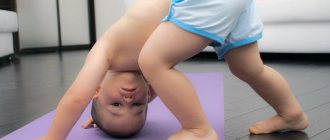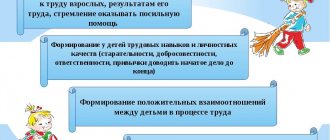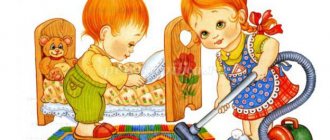The forms and methods of labor education are varied. They depend on the age and other characteristics of the children being raised; are aimed at developing the following qualities: hard work, discipline, conscientiousness, desire for results.
Fostering hard work begins early in life. In the family, then in a preschool institution, basic skills are instilled: ideas about responsibilities, responsibility and discipline. In the future, the forms become more complex and have a specialized character.
The main goal of instilling industriousness is the formation of a little person’s psychological and practical readiness for work . Labor education is very closely connected with civic and moral education; it forms the foundation of creative activity, productivity in studies, sports, amateur performances, and other areas of activity. It is a component of the moral development of the individual.
New trends in labor education methods
Economic, social, environmental conditions determine the constant improvement of labor training and education methods: the emergence of new technologies, the introduction of the latest forms, methods, and techniques. They are based on the principle of variability.
While maintaining the unity of state requirements and their typical nature, labor education programs are drawn up taking into account the composition of those being educated, their age, regional characteristics, and traditions. This opens up opportunities for reducing the use of reproductive methods and increasing the proportion of research and creative forms of work. Inclusion in the labor sphere is carried out taking into account the physiological characteristics , psychological and social readiness of children, taking into account interests and inclinations.
Conditions for successful educational activities
When upbringing, the order of actions, the distribution of responsibilities in the team, the appointment of those responsible, and the availability of forms for summing up are of particular importance. Practical demonstration, training in the main methods, techniques, and compliance with safety are important. It is necessary to use incentives and, if necessary, punishment and censure. Public recognition of work results and approval by adults play an important role.
?
The main condition for success is the inclusion of the child in activities that are feasible for his age and physical capabilities. If it is organized correctly, it will contribute to the formation of the necessary moral qualities: hard work, accuracy, discipline, diligence, perseverance.
Labor becomes educational under several conditions:
- It must be significant and socially useful. This is the only way to realize the significance of the work. Understanding that it brings benefits to people gives additional motivation for work activity;
- The result should be something useful, of value for the team, for oneself and for adults. If the child does not see results, there is not much benefit from the work, the desire to work may disappear;
- Work must be collective. This is the implementation of assigned tasks together, capable of uniting with a common goal. It provides an opportunity to gain experience of interaction, mutual assistance, and solidarity;
- He must be proactive, preferably creative, various forms of self-government and self-organization must be used;
- Labor must be feasible, if possible connected with educational or other educational activities, it cannot be coercion, and punishing a child with it is unacceptable;
- You need to demand not just that the assigned task be completed, but that it be completed carefully and conscientiously.
Goals and objectives of labor education of preschool children
Only if these conditions are met can labor be considered a real means of shaping the personality of a new generation.
We recommend “Problems of labor education of preschool children.”
Instilling hard work in preschoolers
Preschool children should respect the work of others, be responsible, thrifty, caring, be able to work in a team of peers and positively evaluate their work, and be able to organize work. All these skills should be developed in children by adults, and this should be done gradually. First, it is necessary to instill this or that skill, and then improve and consolidate it.
At this age, children are taught household work, self-service, manual labor and outdoor work, as well as various types of duty. Each type of work develops in its own way and according to age. Thus, household work consists in the child mastering the habit of maintaining order at home and on the property, cleaning up toys and leaves on the street.
Self-care is the ability to meet your daily needs. Starting from the age of five, children can already be asked to wash their small items. The frequency of work on self-service skills depends on the age of the children and the degree of their mastery.
Manual labor is based on maintaining order in the household. So, a preschooler, of course, under the guidance of an adult, can sew a button, glue a book, or make a souvenir from scrap material. Work in nature consists of working in a vegetable garden, in a corner of nature, in a garden. Here a preschooler can water the beds or flowers, plant onions, harvest crops, and so on. Closer to school age, you can give your child tasks to care for gardening equipment. At the same age, children are able to be on duty in the area assigned to them: sweep paths, help kids, etc.
Preschool children's attitude towards work will be formed in direct dependence on the importance adults will attach to it. That is, a child can experience both joy from work and a negative attitude towards it. The latter option can happen when uninteresting methods are used in the labor education of preschoolers. It is necessary to develop a child’s interest in feasible work.
A child is more interested in work if it intersects with play. The preschooler simply stops noticing that this is a game. Work activity should contain such techniques as mystery and competition.
In the labor education of preschool children, scenes with toys are used. You can act out a scene with a plastic or rubber pig. Her face should be smeared with something that can be easily washed off. The adult asks Piggy questions about why she is so dirty and what needs to be done to become clean. Piggy can reach out to the child to kiss him. The answer to the question of what Piggy needs to do must be given by the child.
Hand washing can also be accompanied by a game. Before this procedure, preschoolers should be told about the visit of one of the cartoon characters and about his distrust that children can wash their hands without leaving marks on the towel. This will be an incentive to show your favorite character how skillfully children can wash their hands.
Kids love everything secret, so any type of work activity can be turned into a secret. For example, cleaning the area can be presented in the form of the following game: tell the children that the janitor who is cleaning up the yard is very tired and needs to help him. What if the janitor comes to clean, but it’s clean here. Let him think that it was the kind Carlson who helped him.
Properly rewarding children's success
Encouraging a child to achieve success is a kind of parenting trick. It is necessary to constantly encourage, but this does not mean that children need to be showered with gifts. Financial encouragement is also welcome, but you need to be able to do it correctly. A child’s self-confidence, activity and independence are lost if he is constantly given gifts for his success. Therefore, try to encourage non-materially, but simply by praising or recognizing the importance of the child.
The baby becomes dependent on rewards if every correct action is accompanied by a gift. For example, parents say, “If you tidy up your toys, we’ll buy you a car.” The child develops the idea that his successes are needed not by himself, but by his parents. And this cannot be allowed.
To show a positive assessment of the baby’s actions, it is enough to use the right word . You can say that you are happy about his success. The child will be in a better mood and will be happy to do something else good.
To reward your child for success, you just need to nod, look kindly, show an approving gesture, present a gift or simply praise with a word. However, there is a small nuance here: you need to praise only for worthwhile deeds and actions, and not for habits and daily responsibilities. Otherwise, praise will create a habit in the child and he will stop striving for success.
Encouragement should be sincere and directed not at the individual, but at the action. In the labor education of children, the main thing is not to be hypocritical or disingenuous. They feel and understand this well. Be honest with your baby.
Is it necessary to separate the labor education of boys and girls?
If we talk about gender differences in children of early and preschool age, then it is worth considering one condition: the labor education of boys and girls should be different. This is due, first of all, to different understandings of the purpose of men and women. Let's turn to folk concepts.
A woman has always been perceived as a keeper of the hearth and a mother. She took care of the family, raising children and running the household. These responsibilities of women continue today. The man is the head of the family. He is its basis and support. The man not only provided for the family financially, but also did hard housework. From these differences, the main tasks of labor education of children began to form.
This is why girls and boys are raised differently. Girls are engaged in putting things in order in a room or area: planting flowers, watering plants, putting away toys, etc. Boys help in planting trees, carrying books or toys, etc.
There are many general methods of labor education for children. But do not forget about their gender differences. Therefore, using general methods of education, you should pay attention to the choice of methods for developing labor skills in girls and boys.
Types of labor education
The typology of labor education is determined by the type of work performed by the child. It is customary to highlight:
- educational work (physical, mental);
- socially useful;
- production (work to create significant material assets.
Education in educational work is the assimilation, acquisition of the necessary skills, a means of preparation for social labor activity, creativity.
Education through socially useful labor (domestic, social and organizational) includes practical training, work in canteens, on school grounds, collecting scrap metal, planting forests, helping with cleaning, caring for the elderly. This type is intended to show the importance of work activities for society and allows the child to receive moral satisfaction from his activities.
Household work , part of socially useful work, is aimed at satisfying the everyday needs of both the child himself and the team.
Productive work is more suitable for high school age. It is usually paid and is a transition to the real work of an adult.
Early childhood education
Labor education of preschool children includes the following types of activities:
- Self-care – servicing oneself (washing, caring for oneself and others);
- Household - maintaining cleanliness and order at home, in a preschool institution;
- Work in nature: caring for plants, feeding animals;
- Manual, artistic and applied labor contributes to the development of basic skills, abilities, knowledge (work on crafts from different materials, modeling, drawing and other types).
Labor education of young children
Dear friends, we are pleased to introduce you to Yulia Vladimirovna Volkova, teacher at GBDOU No. 100 in St. Petersburg . Today Yulia Vladimirovna is pleased to share with us useful material about how important it is to teach children to work. The article will be useful to both teachers and parents.
Brief commentary on the article from Yulia Vladimirovna:
“The labor education of young children is a very important point. Because you need to know that work is not easy for everyone. And the child needs to be taught to work, so that in the future, in life, he will not be a quitter and a slacker. As you know, hardworking people achieve great heights in this life, lazy people do not live. The development of children and work go hand in hand.”
Useful reading...
Labor education of young children
Labor education should be part of a child’s life from a very early age and carried out consistently and systematically.
A young child loves to play, and for him, work can easily be turned into a game. When a mother cleans the room, she can involve the child in this work. Labor education of young children, of course, is carried out not only at home, but also in kindergarten. Labor education of young children is to be able to support all the child’s endeavors.
In the second and third years of life, the child masters individual productive work actions (unfasten buttons, remove stockings, etc.). Mastery of these actions and the simplest elementary productive activities leads to the further development of voluntary movements, the formation of various motor skills, and awakens the child’s interest in the actions of adults and simple labor processes. Thus, at an early age, very significant prerequisites for the further development of work activity are formed. In accordance with this, the tasks of labor education are set: 1. To form in children effective and then productive manual and instrumental actions and, on this basis, elementary labor actions for self-service. 2. Instill in children an interest in the work activities of adults.
Labor education of young children is not only help with cleaning the house (wipe the dust, hold the handle of the vacuum cleaner, wash the floors a little, put things in their places), but also other skills and abilities.
Solving the problems of labor education is most purposefully carried out from the second year of life. The content of labor education in the second year is determined by the children’s capabilities and the characteristics of the development of the prerequisites for labor activity. In the first half of the year, this is the formation of effective and instrumental actions and simple labor actions (labor skills) for self-service: eating with a spoon, taking off tights, unlaced shoes, washing off soap suds from hands under running water, etc. In the second half of the year, children continue to learn how to wash their hands , learn to eat independently, take off pieces of clothing unbuttoned and untied by adults, and not throw them around.
In the third year of life, the content of self-care becomes more complicated. Children must master the process of washing hands, dressing and undressing, learning to unbutton and fasten buttons in the front, lace shoes, put on items of clothing in a certain order, notice untidiness in a suit and eliminate it with the help of adults.
At the same time, children begin to be involved in performing simple labor actions with similar results: bring some objects, put a plate of bread on the table, collect cubes from the floor into a box, etc.
Elementary labor activities present significant difficulties for children of the second and third years of life, and their development requires careful pedagogical guidance. The teacher develops self-service skills, relying on the great interest of children of this age in independent actions with objects, on greater imitation of the actions of an adult. The teacher supports and encourages all attempts to independently achieve results (“I do it myself!”). However, in order for a child to achieve a result, the baby must be taught to see it and taught the appropriate actions. This is done by adults both during self-service and in the process of household work, where the child is only a spectator, for example: they washed their hands - they became clean; wiped with a towel - they became dry and clean; We ironed the dolls' dresses - they became beautiful, ironed. The emotional reaction of an adult to achieving a result forms an emotionally positive attitude towards him and the child, awakens the desire to achieve it. An explanation from an adult once again allows you to connect the process of action with the result and goal: you washed your hands, they became clean - you can go to lunch. Learning to work is carried out in the process of individual communication with the child, in the process of caring for him. Teaching includes a leisurely demonstration, an explanation of how to perform first one, and then a series of actions in sequence, and direct assistance. In some cases, an adult can help the child correctly take the object with which the baby must act, put a spoon, a towel in the child’s hands in order to use them correctly, or a plate of bread to move it. In other cases, an adult acts with the child’s hands, giving him the opportunity to show effort, to feel the action being performed: to remove tights or boots from his feet, etc. As labor actions are mastered, the teacher helps only when performing the most difficult ones for the child, and then simply prompts the next action which the child performs (first straighten the towel on your hands, then wipe your face, etc.). Every child's success must be celebrated. Encouragement creates a joyful mood in the child, a desire to repeat the action, to achieve the desired result. To consolidate the initial labor actions, the following conditions are necessary: a) demonstration, explanation and exercise in actions; b) consistency of requirements for children in kindergarten and in the family (children themselves perform feasible self-care activities); c) constancy of requirements for the sequence of execution, quality of work actions and results; d) a calm business environment that takes into account the child’s capabilities; e) transition from individual learning to group learning as the actions are mastered and the ability to listen to an adult.
The independence of a child of this age in self-care is based on the development of the skills of buttoning, unfastening, lacing, etc. In the formation of such skills, play exercises are widely used: dressing dolls, when children repeatedly button or unfasten their clothes. There are also specially made teaching aids - different types of fasteners. Children willingly practice quite complex movements and master the necessary skills.
In order to consolidate the sequence of labor actions for self-care (dressing, undressing, washing, etc.), classes are conducted using game techniques.
The labor education of young children does not go unnoticed by toy developers. Nowadays you can buy special toys in stores that develop various work skills in children. For example, this is a board in the shape of boots, with real laces that need to not only be tied, but also laced first. Or a toy, clothing, to which it is attached by lacing through holes and tying. In addition, there are many other interesting toys that develop the labor education of young children. Role-playing games also play an important role in the labor education of young children. Let someone be a janitor, and someone a cook. Let your child prepare his own porridge - add the amount of salt and butter you prepared in advance to the prepared porridge and stir. This is a kind of work, but at the same time a game. Children's development in a playful way is much better perceived by children.
In addition, labor education of young children can also be carried out in active games with dolls. What does it mean? The child must wash and undress the doll himself and put her to bed, and while she sleeps, prepare the doll to eat. You can also offer to take the doll with you before the walk, but to prevent the doll from freezing, let the child dress it himself.
Young children love to give their dolls tea, and when they come home from the street, you can offer the child to give the doll some tea to keep it warm. The child is also still learning to take care of his neighbor. This is not only labor education, but also moral education. And after the child gives the doll tea, he can wash the dishes himself.
Of course, before demanding any action from a child, you need to thoroughly explain to him exactly how all this is done and even show him. If a child does something wrong, just show him how to do it.
Games are also used to improve instrumental skills: children are taught to use a scoop, a spatula to pour sand into molds, hammer pegs with a wooden hammer, etc.
All this ensures not only learning, but also habituation, i.e. fostering the habit of acting in certain conditions in a learned manner. A small child develops habits quickly and quickly fades away. Therefore, it is necessary to constantly repeat labor actions, taking into account the capabilities of the growing child.
Thus, the methodology of labor education provides for the formation of labor actions in young children, their focus on results and the desire to overcome feasible difficulties in the process of achieving results.
Forms of labor education
Even Makarenko A. was looking for forms of organization that contributed to the formation of a developed and purposeful personality. The main idea of his system was education through labor in the team and through the team. Not everyone knows what form was proposed by Makarenko for the effective education of the younger generation. This form became a combined detachment, which received a modern continuation in the form of squads and volunteer detachments.
All forms aimed at developing hard work are combined into several groups:
- Individual (fulfillment of orders, individual tasks and requirements);
- Collective (socially useful type of work) is aimed at the child’s adaptation in society and the team;
- Group (holidays, matinees, competitions).
There are many forms of education. They are subject to certain conditions. The most popular forms: individual assignments, various types of social work (volunteer teams, shifts, holidays, cleaning, landscaping, landscaping, repairing furniture and textbooks).
Effective forms of developing the right personal attitude towards work are:
- work in units to perform work;
- development of labor traditions;
- shows, exhibitions, competitions;
- detachments and labor landing;
- individual orders.
The labor education system uses the maximum possible number of forms to ensure the education of responsibility, hard work, organization, and collectivism in the younger generation.
Forms of work with preschoolers
The number of forms for preschool children is also quite large. They are distinguished by their simplicity and at the same time invaluable power in educational impact. The most used forms in preschool education:
- Assignments (individual, group and general; short-term, long-term);
- Duty - organization of activities that involve work to serve oneself and the children's team;
- Collective, joint activity is the activity of a group of children united by one goal.
Creativity can also be called one of the forms of developing labor qualities in a preschool educational institution.
Methods of labor education
There are several groups of methods:
- Methods of forming consciousness, used to form views, ideals, beliefs, attitudes. They contribute to the formation of feelings and moral experiences. Methods of personality formation are methods of persuasion: they convince the child of the correctness of actions, allow him to understand the need for work as an obligatory part of society . Persuasion can be achieved using methods: stories, explanations, suggestion, instruction, example, conversations;
- Methods of organizing socially significant activities allow the child to understand the role of his work and the benefits it brings;
- Stimulation methods: proper encouragement or punishment, competition. Approval from adults is always important; as a result, the child can experience inner satisfaction, the realization that he has achieved success in completing the task. Blame is also important.
Labor activity in the senior group in the classroom
The choice of methods depends on the goals and objectives, the individual characteristics of the individual child, and the level of work readiness.
How to teach a child to work?
Early age is the initial period of labor education of children. It is at this time that the prerequisites for work are laid. The baby can already understand the connection between the action performed and the result obtained. In early childhood, voluntary movements and instrumental actions develop. The baby is already able to perform productive activities. Moreover, it contains the desire to solve simple problems without the help of adults.
First, the baby masters voluntary hand movements. This occurs towards the end of the first six months of life. Then the movements are combined into a single system, which allows the child to achieve a certain result of his actions: throwing a rattle out of the crib, grabbing a toy, etc. Thanks to the participation of adults in the labor education of children, these actions become more complicated. The child can already put rings on the rod of the pyramid, put some objects into others, and so on.
The development of instrumental actions allows the baby to use a spoon, cup, spatula and other similar objects. Later, the child learns to take off socks, unfasten buttons, etc. By mastering simple actions, the child develops motor skills and an interest in work activities.
In the second year of life, the development of self-service begins. First, kids learn something, then consolidate their acquired skills. By the age of three, self-care begins to become more difficult. Children do not easily wash their hands or take off their pants, but do it consciously, in a certain order. Naturally, children still cannot do without the help of their parents.
Training in labor actions should take place individually , in the process of caring for a child and communicating with him. The adult must explain and show the child how to perform this or that action. At first it can be one task, and then several sequential actions. An adult can help the child pick up a spoon correctly or give him a plate of bread to take to the table. In some cases, the parent must act with the baby’s hands so that he understands how this or that action is performed.
When a child has mastered basic work actions, he only needs to be told what needs to be done. Help can only be provided in difficult situations for the child. After performing an action correctly, the child should be praised. This will not only cause joy in the baby, but will also give an incentive to the desire to do something else useful.
Self-service is formed in the game. You can offer the baby to undress and dress the doll. In this game, the child learns to unbutton and fasten clothes. Self-service actions are reinforced using game techniques. The baby is offered to wash the doll, dress it or put it to bed. Improving a child’s instrumental skills can also be achieved through play: the ability to use a spatula, hammer pegs, etc.
This is how a habit is formed. It tends to fade away quickly, so it is necessary to maintain it by repeating labor actions. So, for example, when washing, the baby rolls up his sleeves, soaps his hands and rinses off the soap with water. Then he straightens the towel and wipes his hands. To prevent your child from getting bored doing all these actions, you can use nursery rhymes. For example, like this:
"Clean water
Washing Katya's face
Larochka palms,
And the fingers are for Ilyushka.”
To teach a child to serve himself, it is necessary to arouse his interest in this. You can include various performances in the activity using toys, for example, organize a table theater. The plot of the game can be different: “The Bear teaches the Tiger Cub to eat correctly” or “How the Chicken washed itself,” etc. In order for the child to correctly perform the acquired skills, it is necessary to constantly monitor this. For this purpose, you can use stories about difficult everyday situations that children face.
When mastering self-service skills, didactic games are also appropriate. The name can be anything. For example, “The bear is frozen,” “We’ll give Katya the doll a bath,” “Let’s treat the little animals.” It is important for parents to know that if they do not pay due attention to how the baby performs this or that action, he will form bad habits and the necessary skills will not develop.





